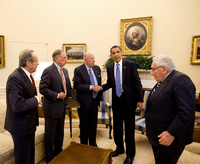For decades now, strategic experts have predicted that our world was on the verge of a break-out in nuclear proliferation that would see us grappling with two- or three-dozen nuclear powers. Indeed, the inexorable spread of nuclear weapons is the closest thing to an unassailable canon in the field of international relations, as one cannot possibly employ the term "nuclear proliferation" without preceding it with the modifier "increasing." This unshakeable belief, wholly unsupported by any actual evidence, drives many Cold War-era "wise men" to argue that mutually assured destruction (MAD) and strategic deterrence in general are obsolete and therefore immoral in the post-Cold War era.
But an examination of the historical record reveals otherwise. It took two decades after the U.S. developed nuclear weapons in 1945 for the world to reach five nuclear powers, all of which, naturally enough, now wield vetoes in the United Nations Security Council. The Soviets, aided by secret-stealing spies, followed the U.S. lead in 1949. America shared nuclear weapons technology with Canada, the United Kingdom and -- indirectly -- France, with the latter two becoming nuclear powers in 1952 and 1960 respectively. The Soviets then shared technology with China, which became a nuclear power in 1964. Meanwhile, Australia tried to gain access to the U.K.'s technology for years, but eventually gave up.
As for some of the other candidates from the Cold War framework, Germany and Japan have long had the intellectual and industrial capacity to create weapons programs, but have chosen not to. They logically would have been Nos. 8 and 9, after Canada and Australia, if the nuclear attraction was as strong as proliferation alarmists claim. Both Sweden and Switzerland also looked seriously into weapons, but signed the Nuclear Non-Proliferation Treaty (NPT) instead. They would have brought the total to 11. On the Soviet side, Poland, Romania and the former Yugoslavia -- most logically in the follow-on form of Serbia -- could have conceivably gone all the way with various programs they pursued. They would have boosted our total to 14.

